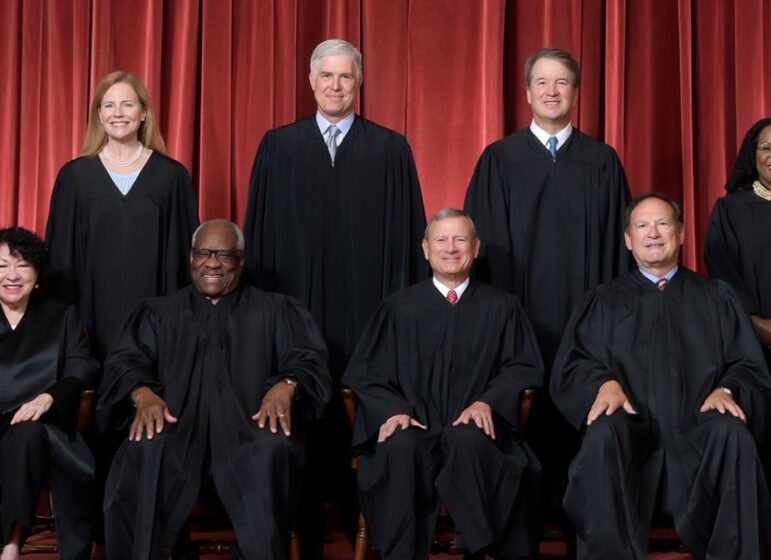
The U.S. Supreme Court on Thursday rejected race-based admissions in higher education at Harvard University and the University of North Carolina at Chapel Hill (UNC). The judgment likely bring into question the legality of a lot of race-based college admissions policies, particularly at elite colleges.
In the ruling (Trainees for Fair Admissions v. Harvard) a majority of the justices ruled that using racial choices in the admissions process at the two colleges broke the Equal Protection Clause of the Fourteenth Amendment. Federal law did not need racial preferences in admissions at the time of the ruling, but the federal government endured the prejudiced usage of racial choices by higher education institutions. This toleration persisted for years in spite of the scheme’s obvious violation of federal legislation that educational institutions– amongst lots of other institutions and personal companies– can not victimize candidates based upon membership within any specific racial or ethnic group.
Therefore, opponents of affirmative action– most of them conservatives– have fallen all over themselves to applaud Thursday’s decision as an excellent victory. For those who wish for Supreme Court choices that in fact do something to limit federal power or safeguard private property, however, this choice contains little to applaud. Rather, the court’s ruling this week reiterates the power of the federal government to govern essentially every organization in America in the name of fighting discrimination. Even worse is the reality that the court might have– and should have– ruled versus Harvard and UNC using nothing more than Title VI of the Civil Rights Act. That would have really restricted federal power. Instead, the court took a various course developed to strengthen federal power and re-assert federal authorities.
Simply put, opponents of affirmative action have won a little skirmish for their little cause, however opponents of program power have actually won nothing at all.
The Problem with the Equal Security Provision
One of the most pernicious developments in the history of federal law was the adoption of the so-called “Equal Defense Stipulation” (discovered in the Fourteenth Change).
This new area of the constitution, adopted in 1868, turns the Expense of Rights on its head. The Costs of Rights, of course, was composed to limit federal power only. It’s why the First Modification starts with the expression “Congress shall make no law …” Keep in mind there is no mention of state legislatures. It was just after the adoption of the Fourteenth Amendment that federal courts took upon themselves new powers to require every state and local government to abide by federal courts’ unique analyses of the Expense of Rights. Called “incorporation” this brand-new legal teaching guaranteed that the Costs of Rights worked to broaden federal power rather than limit it. As a result, the United States ceased to be a real confederation of states– as described by the Constitution as validated in 1788– and moved much even more towards becoming a unitary state.
[Read More: “End the Incorporation Teaching” by Ryan McMaken]
Furthermore, gradually, federal courts started to apply the Equal Security Clause far beyond even the deeds of state and city governments. Legal scholar Allen Mendenhall has summed up the damage done:
the Supreme Court would later rely on the Equal Defense Stipulation and the Due Process Clause to overrule state laws under the Fourteenth Amendment. However the Supreme Court has actually not stopped at state laws: gradually it has used the Equal Security Stipulation and the Due Process Provision as a pretext for regulating private citizens and businesses. The Fourteenth Amendment, which was planned to minimize discrimination, has actually even been used, paradoxically, to support affirmative-action programs that discriminate against particular classes of people.
Ceding power to federal judges does not incline them to liberty. Due To The Fact That Area Five of the Fourteenth Amendment permits Congress to pass amendments or enact laws handling state infringements on individual liberty, it isn’t required or constitutionally sound for the federal judiciary to presume that role. Members of Congress, unlike federal judges who take pleasure in life period, are responsible to the citizens in their states and are thus more likely to experience their infidelity to the Constitution.
Hence, it has actually become commonplace for federal judges to justify federal meddling in personal organizations and other private institutions. Unfortunately, so-called conservative judges are no various, and they have been more than delighted to maintain and expand the reach of the federal government utilizing the Equal Security Clause as justification.
This Is No Success Versus Federal “Anti-Discrimination” Plans
We see this in this week’s judgment from the Supreme Court. The court’s viewpoint bases its judgment against the University of North Carolina and Harvard University– a state institution and a private university respectively– on the Equal Defense Provision. This is clear in the judgment as written by the ultra-establishment judge John Roberts (who likewise ruled in favor of Obamacare):
For the reasons supplied above, the Harvard and UNC admissions programs can not be fixed up with the assurances of the Equal Security Provision … Respondents’ admissions systems– nevertheless well intentioned and implemented in excellent faith– … must therefore be revoked under the Equal Defense Provision of the Fourteenth Change.
Keep in mind, federal law does not mandate affirmative action at UNC or Horvard. So, to rule against these affirmative action plans is not to rule against any federal law, nor does such a judgment limitation federal law in any method. Rather, the judgment asserts that federal courts get to choose what state legislatures and the Harvard governing boards finish with their residential or commercial property.
Of course, this will not trouble most conservative challengers of Affirmative Action, few of whom could possibly care less about abuses of federal power so long as that abuse and arbitrary power is directed against the opposite. Those who have no long-lasting technique against federal power– and who do not have any principled position in assistance of personal property, local control, or real federalism– will not have any problem with the court’s ruling.
The reality that the conservative wing of the court selected to double down on the Equal Security Provision reveals its centralist leanings due to the fact that it could have simply as easily ruled against affirmative action based on Title VI of the 1964 Civil Liberty Act. Title VI specifies:
No individual in the United States shall, on the ground of race, color, or nationwide origin, be omitted from participation in, be denied the advantages of, or undergo discrimination under any program or activity receiving Federal monetary support.
Were Harvard University a really personal organization, it should be totally approximately that organization regarding how it picks to admit students. Likewise, if UNC were truly a state-level institution, how the University of North Carolina conductions its admissions process ought to be a matter for people in North Carolina.
Yet, as is popular, both of these institutions have received massive piles of federal money in current decades. This has come both in the type of straight-out grants, and in the type of federal trainee loans which enables institution of higher learnings to trek prices well beyond what trainees might pay without those loans. When it concerns grants, the dollar quantities are remarkable to say the least. In 2019, federal dollars comprised 70 percent of Harvard’s $800 million in research study grants. The University of North Carolina got more than $700 million in federal research study dollars in 2019.
In other words, both of these organizations are quasi-federal setups, and certainly fall under the arrangements of Title VI. The truth that these institutions were utilizing race-based admissions policies– i.e., victimizing candidates without the “appropriate” group background– means those who pay federal tax were required to pay for these institutions’ inequitable practices. The entire point of Title VI is to end such abuses.
A last note: lest the reader have any remaining doubts that Roberts’ judgment takes care to not really restrict the federal government in any method, we can highlight footnote 4 on page 22:
The United States as amicus curiae contends that race-based admissions programs even more engaging interests at our Nation’s military academies. No military college is a celebration to these cases, however, and none of the courts below addressed the propriety of race-based admissions systems because context. This opinion likewise does not address the problem, in light of the potentially unique interests that military colleges may provide.
Had actually the court based its opinion on Title VI instead of the Equal Security Clause, it would have been exceptionally hard to reject that the military academies– which are, naturally, federally moneyed– should stop any and all race-based preferences in admissions or any other element of administration. Yet, by decreasing the role of Title VI, the court found a hassle-free method to prevent the apparent.
Not all of the SCOTUS judges chose to strategically disregard this fact. In his concurring viewpoint, Justice Gorsuch, the least-bad member of the court, specifically invoked Title VI as an enough reason to decline race-based admissions schemes at Harvard and UNC. He composes:
Title VI bears independent force beyond the Equal Protection Stipulation. Absolutely nothing in it approves special deference to university administrators. Nothing in it endorses racial discrimination to any degree or for any purpose. … And nobody can question that both schools purposefully treat some applicants even worse than others at least in part because of their race.
Gorsuch concludes “Title VI of the Civil Rights Act of 1964 does not [endure] the prejudiced practices used at Harvard and UNC.
Simply put, the court could have actually ruled against affirmative action without depending on freedom-destroying arrangements like the Equal Protection Stipulation. Had the court ruled strictly along the lines of implementing Title VI, the court’s choice would have sent the message that the decades-old policy of shoveling federal taxpayer cash to bigoted admissions officers was at an end. If the court’s conservative wing in fact respected personal property and real federalism it would have made it clear that– as far as federal law is concerned– organizations would still be complimentary to discriminate as they please offered they receive no federal money.
But that’s not what the court did. Instead it picked to perpetuate the court’s reputable and disastrous usage of the Equal Protection Provision to make sure the federal government possesses nearly untrammeled power in the name of combatting discrimination.

